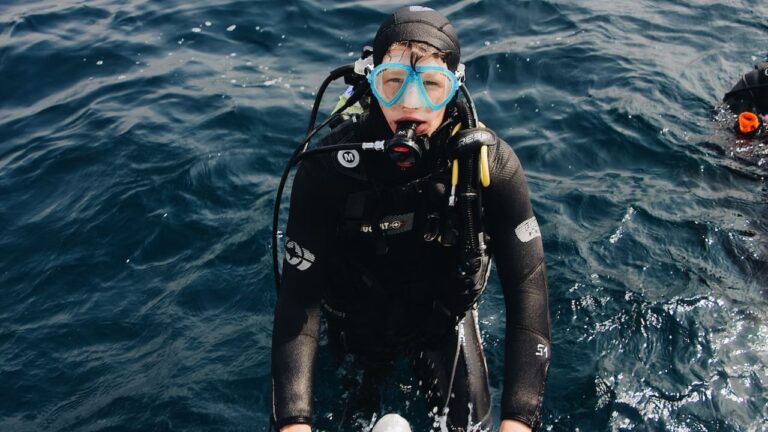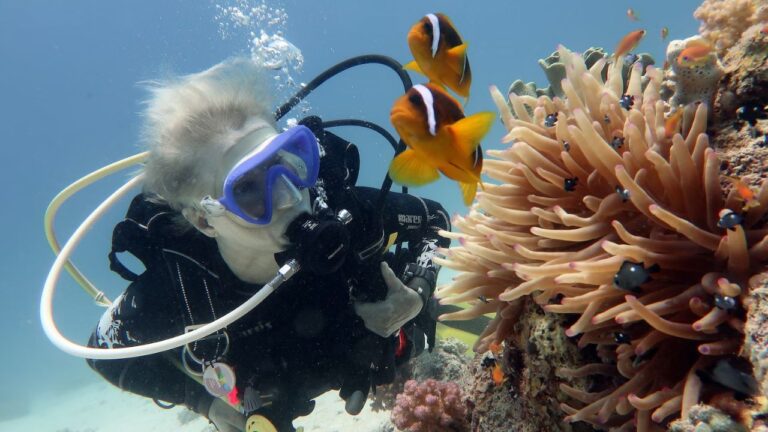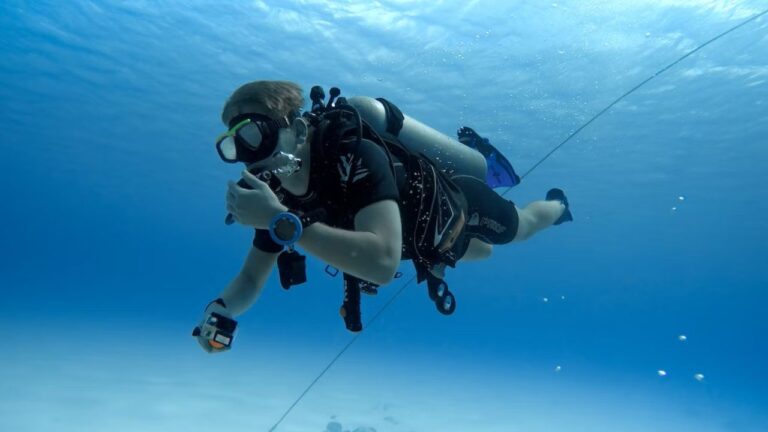Are you dreaming of exploring the underwater world but worried about the costs? Well, I can understand your concern.
Scuba diving is an incredible experience that lets you witness the beauty of marine life up close and personal. However, it’s no secret that it can be an expensive hobby.
There are several costs that can add up quickly, from purchasing or renting gear to taking courses and getting certified. But don’t let the price tag deter you!
Understanding the various costs and budgeting accordingly can make your scuba diving dream a reality. And that’s just what we’re gonna do through this article.
On average, a US-based scuba diver could expect to spend anywhere from $1000 to $5000 yearly on scuba diving-related expenses. The actual costs vary greatly depending on location, equipment type, diving frequency, and individual preferences.
If you’re in a rush, just check out this table. Although, I do recommend going through the article so I can help you with budgeting.
| Cost Category | Average Cost (USD) |
| Gear and Equipment | 500-3000 |
| Scuba Lessons and Certifications | 200-1000 |
| Dive Trips | 75-200 per dive |
| Dive Club Memberships | 50-500 per year |
| Air and Nitrox Refills | 5-15 per tank fill |
| Dive Insurance | 100-500 per year |
| Maintenance and Repair Costs | Varies |
Let’s dive in (pun intended) with the first expense you’ll face – scuba lessons.
1. Scuba Lessons and Certifications
Diving requires proper training and certification to ensure your safety and enjoyment underwater. Granted, it may be expensive, but investing in proper education and certification is crucial for your safety and the safety of others around you.
These lessons and certifications are designed to teach you the fundamentals of diving, including the proper use of equipment, underwater communication, and emergency procedures.
Certification agencies such as PADI (Professional Association of Diving Instructors) and NAUI (National Association of Underwater Instructors) offer many courses catering to beginners and experienced divers.

Cost of Certifications
The cost of scuba diving lessons and certifications varies depending on the level of training and the location where you choose to receive your education. Generally, scuba diving lessons range from $200 to $1000, depending on the course’s complexity and duration.
Open Water Diver certification is the most popular course, costing around $300 to $500. Advanced Open Water Diver certification costs around $300 to $500 and teaches advanced diving skills such as deep diving, navigation, and underwater photography.
Other certifications, such as Rescue Diver and Divemaster certification, can cost up to $1000 or more, requiring more extensive training and experience.
Additional Learning Costs
PADI offers a variety of e-learning courses that allow you to complete the classroom portion of your scuba diving certification online. The cost of e-learning courses varies depending on the level of training and the course material.
PADI’s Open Water Diver e-learning course costs around $190, while the Advanced Open Water Diver e-learning course costs around $160.
Textbooks and study materials are also necessary for scuba diving education, and the cost varies depending on the certification agency and the course level.
For example, PADI’s Open Water Diver manual costs around $80, while the Rescue Diver manual costs around $50.
Tips for Saving Money on Education
Putting the importance aside, no one can deny that scuba diving education is expensive. Still, there are ways to save money without compromising your safety and the quality of your training.
Here are some tips for saving money on scuba diving education:
- Shop around for the best prices: Different dive shops and certification agencies offer different prices for scuba diving lessons and certifications. Take the time to compare prices and find the best deals.
- Choose a reputable certification agency: This ensures that you receive high-quality training that is recognized internationally.
- Join a local dive club: Joining a local dive club can help you save money on scuba diving lessons and certifications. Many dive clubs offer discounts on training and equipment purchases.
- Take advantage of package deals: Many dive shops offer package deals that include scuba diving lessons, gear rentals, and certification. These package deals can be a cost-effective way to receive your scuba diving education.
You can also try saving money on other things like gear and equipment. I’ll explain that next.
2. Gear and Equipment
As a beginner, you may be tempted to rent your gear, but investing in your gear can quickly become more cost-effective if you plan on diving frequently.
For scuba diving, you’re gonna need a wetsuit, fins, a mask, a regulator, a buoyancy compensator device (BCD), a dive computer, and a tank.

Cost of Purchasing or Renting
Purchasing a full set of new scuba gear can cost anywhere from $2,000 to $4,000 while renting gear for a single dive can cost around $50 to $100.
If you plan on buying stuff separately, a good quality wetsuit can cost anywhere from $200 to $500, while fins and masks can cost around $50 to $100 each.
Other optional gear includes dive lights, dive knives, and underwater cameras, each of which can add to the cost of your scuba diving experience.
Investing in quality equipment that will last and perform well is important when purchasing gear. You can often find good deals on used gear, but be sure to have it inspected by a professional before buying.
Cost of Repair & Maintenance
Like any other gear, your scuba diving kit will require regular maintenance and occasional repairs to ensure proper function and safety. This includes servicing your regulator, BCD, and dive computer and replacing parts.
The cost of scuba diving gear maintenance and repairs can vary depending on the type and extent of the work needed. On average, a full service of your gear can cost around $50 to $300.
Several factors can impact the cost of equipment maintenance and repair. Firstly, the type of gear plays a significant role in determining the cost. Basic equipment such as a snorkel or a pair of fins may require minimal maintenance, whereas more complex gear like dive computers, regulators, and BCDs may require more attention and cost more to maintain.
Another factor is the frequency of use. Gear used frequently may require frequent maintenance and wear out faster than equipment used less frequently.
Location is another critical factor that can impact equipment maintenance and repair costs. Scuba diving shops and repair facilities in tourist destinations may charge more than those in less popular areas.
Furthermore, scuba diving gear prices can vary between different countries and regions, so it is essential to consider these factors when purchasing equipment or planning a diving trip.
Tips on Keeping Your Gear Maintained
Following these tips can help keep your scuba diving gear in top condition, prolonging its lifespan and ensuring your safety underwater.
1. Rinse gear with fresh water.
After every dive, rinse all gear (including regulators, dive computers, masks, and fins) with fresh water to remove salt and other debris. This helps prevent corrosion and prolongs the lifespan of your equipment.
2. Store gear properly.
Store your gear in a cool, dry place away from direct sunlight. Avoid hanging wetsuits by the shoulders, as this can cause them to stretch out of shape. Instead, fold them neatly and store them in a bag or hanger.
3. Service gear regularly.
Regular servicing of your scuba gear is essential for maintaining its performance and safety. Regulators should be serviced annually or after 100 dives, whichever comes first. BCDs, tanks, and dive computers should also be serviced regularly.
4. Check O-rings.
Before every dive, check the O-rings on your regulators and tank valves for signs of wear or damage. Replace any O-rings that show signs of wear, as a faulty O-ring can cause a leak and compromise your safety underwater.
5. Keep gear dry.
Moisture can cause mold and mildew to grow on your gear, leading to foul smells and health issues. Make sure all gear is completely dry before storing it away.
3. Dive Trips
Finally, the most important part. Dive trips are organized excursions that take divers to various dive locations, such as coral reefs, shipwrecks, or other interesting underwater sites.
Generally, dive trips can cost anywhere between $500 to $10,000+, depending on the trip’s level of luxury. These trips can be either domestic or international, and the cost of each trip will depend on location, duration, and the services offered.
One of the most significant costs associated with dive trips is the cost per dive.

Dive trips are typically priced per dive, depending on the dive site’s location and difficulty level. On average, the cost per dive can range from $50 to $200, depending on the dive site’s accessibility and the trip’s services.
In addition to the cost per dive, there are several other expenses to consider when planning a dive trip. These include accommodation, transportation, meals, and dive equipment rental fees.
Accommodation can be one of the most significant expenses, especially if you plan on staying at a luxury resort. Transportation costs will depend on the location of the dive site, and if it requires air travel, the cost can quickly add up.
When planning a dive trip, it’s essential to research the location’s dive shops and the prices they charge for equipment rental. Some dive shops may offer equipment rental as part of the dive trip package, while others may charge separately. Diving insurance is important too for these trips.
Dive trips can be an excellent opportunity to explore new dive sites, meet other divers, and gain valuable experience. However, it’s important to remember that dive trips can be costly, and it’s essential to plan accordingly to avoid any financial surprises.
With careful planning and budgeting, dive trips can be an unforgettable experience worth the investment.
4. Dive Insurance
Scuba diving is an exhilarating activity that lets you explore the underwater world but can also be risky. There’s always a chance of unexpected events, such as injury or trip cancelation. This is where dive insurance comes in handy.
Dive insurance offers coverage for scuba divers in case of an accident or unexpected event during a dive trip. It protects divers from financial losses from diving-related incidents, such as decompression sickness, emergency evacuation, or lost or stolen equipment.
Some dive insurance policies may also provide coverage for trip cancellations or interruptions.
The cost of dive insurance varies depending on the policy you choose and the level of coverage you require. Some policies may cost as little as $50 per year, while others can cost $200+. Prices vary according to age, the number of dives planned, and the diving locations.
Benefits of Diving Insurance
1. Medical coverage: One of the main benefits of dive insurance is that it can cover medical expenses in case of a diving-related injury. This can include hyperbaric chamber treatment, doctor’s fees, and hospitalization costs.
2. Trip cancellation coverage: Some dive insurance policies may cover trip cancellations or interruptions due to unforeseen events, such as a sudden illness or a family emergency. This can help you recover any non-refundable expenses related to your dive trips, such as airfare or hotel reservations.
3. Equipment coverage: Dive insurance policies may also cover lost or stolen equipment. This can be particularly useful if you have invested significant money in your scuba diving gear.
4. Peace of mind: Perhaps the most significant benefit of dive insurance is the peace of mind it offers. Knowing that you’re protected against unexpected events can allow you to enjoy your diving experience without worrying about the financial consequences of an accident.
Not all dive insurance policies offer the same level of coverage, so it’s important to do your research before choosing a policy. Some policies may have exclusions or limitations that you should be aware of, so read the fine print carefully.
5. Dive Club Memberships
If you’re a serious scuba diver, joining a dive club could be a great option to save money while enjoying the sport to the fullest.

Dive clubs are organized groups of scuba divers who meet regularly to go diving, share experiences, and participate in social events related to the sport.
They may have a local or national presence, and many are affiliated with larger organizations such as PADI (Professional Association of Diving Instructors) or NAUI (National Association of Underwater Instructors).
Cost of Joining a Dive Club
The cost of joining a dive club can vary depending on the organization and the location. Some clubs may require an annual membership fee, while others charge a monthly or per-dive fee.
In general, the membership fee for scuba diving clubs in the United States can range from $50 to $200 per year, depending on the membership benefits. Some clubs may offer a discounted rate for students or seniors.
Benefits of Dive Club Memberships
One of the most significant advantages is the opportunity to save money. Many dive clubs have partnerships with local dive shops or charter companies, which means members can receive discounts on gear, rentals, and dive trips.
Some clubs also have their own gear rental programs, which can save members even more money. Another benefit of joining a dive club is the social aspect.
Diving can be solitary, but it doesn’t have to be. Dive clubs offer an opportunity to meet other divers, make new friends, and participate in social events related to the sport. Many dive clubs organize trips to exotic locations or local dive sites, providing a fun and exciting way to explore the underwater world.
In addition, some dive clubs offer training programs or continuing education courses for their members. This can be a great way to improve your skills as a diver and learn about new techniques or equipment.
Finally, dive clubs can also provide a sense of community and support for divers. Whether you’re a beginner or an experienced diver, being part of a dive club can offer a sense of belonging and camaraderie with other scuba enthusiasts.
6. Air and Nitrox Refills

Scuba divers need a source of breathing gas to explore the underwater world. While the most common gas is compressed air, some divers opt for nitrox, which contains more oxygen than air.
However, these gases can only last a long time, and divers must refill their tanks periodically. This is where air and nitrox refills come into play.
Air refills are the most common and cheaper too. As compressed air is readily available and widely used, most dive shops offer air refills at a reasonable cost.
The cost of an air refill can vary depending on the dive shop’s location, tank size, and the refills’ frequency. Generally, an air refill can range from $3 to $10 per tank, costing an average of $5 per tank.
On the other hand, Nitrox is a specialized gas mixture that contains more oxygen than regular air. This mixture allows longer dives and shorter surface intervals, making it a popular choice for some divers. However, nitrox is more expensive than compressed air, and not all dive shops offer refills.
A nitrox refill can range from $8 to $20 per tank, depending on the mixture’s location and concentration. On average, a nitrox refill costs around $12 per tank.
To save on costs, you can talk to your local dive shop owners. Some dive shops offer discounts for customers who refill their tanks frequently or purchase a certain number of refills at once.
It’s essential to factor in the cost of air and nitrox refills when planning a scuba diving trip or considering purchasing diving gear. While refills may seem relatively small compared to other diving expenses, they can quickly add up, particularly for frequent divers.
Expert QnA
Q. Is scuba diving an expensive hobby?
Scuba diving can be expensive, especially if you purchase all your gear and dive in exotic locations. However, it’s also possible to find budget-friendly dive shops and destinations, and many divers find the experience worth the cost.
Q. How much does a scuba certification cost?
The cost of scuba certification depends on the agency and level of certification. Basic Open Water certification can cost between $200 and $500, while advanced certification can cost more than $1000.
Q. How much does it cost to rent an oxygen tank?
Oxygen tank rental typically costs around $10 to $15 per day, although this can vary by location. Some dive shops may offer discounts if you rent for multiple days or bring your tank for refilling.
Q. Are there any hidden costs associated with scuba diving?
There are a few additional costs that scuba divers should consider. Some dive sites require a park entrance or boat rental fee. Additionally, it’s important to consider travel insurance and other travel costs when making your budget.
Q. How often do you need to replace the scuba diving tank?
Ideally, you must replace your scuba diving tank every five years, regardless of how frequently they are used. It’s also important to regularly inspect the tank for signs of damage and wear and to follow the manufacturer’s guidelines for maintenance and replacement.
For your sake, replace the tank immediately if you detect any signs of damage or wear.
Q. How much does a full scuba setup cost?
A full scuba setup can cost anywhere from $1,500 to $3,500. This includes a wetsuit, regulator, BCD, fins, mask, and dive computer. Additionally, prices may vary based on whether you choose to purchase new or used equipment.
Investing in high-quality gear to ensure safety and longevity is important, but there are ways to save money, such as purchasing secondhand or looking for sales and discounts.




